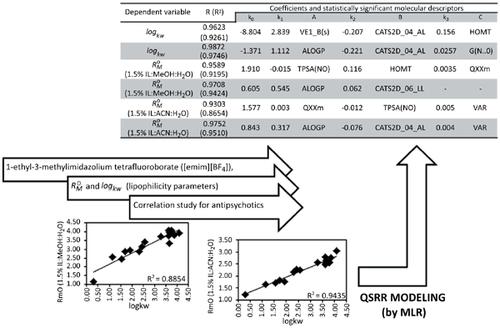Medicinal Chemistry ( IF 1.9 ) Pub Date : 2020-10-31 , DOI: 10.2174/1573406415666190723162959 Dominik Mieszkowski 1 , Marcin Koba 2 , Michał Piotr Marszałł 1

|
Background: Reversed-phase liquid chromatography may cause difficulties, especially in the case of basic drugs due to the strong silanophilic interactions in the partition mechanism. Recently, imidazolium-based ionic liquids additives appeared interesting and a convenient solution for suppressing the harmful effect of free residuals of silanol groups, allowing remodeling of the stationary/mobile-phase system, and thus improving the lipophilicity assessment process.
Objective: The aim of the study was to evaluate the retention behavior of basic antipsychotics using various RP-LC systems, and compare them with data obtained from the modified ionic-liquids RP-TLC systems, and perform the QSRR analysis.
Methods: Retention and lipophilicity parameters of diverse antipsychotics have been examined in various RP-LC systems. Lipophilicity indices were compared with miscellaneous computed logP values. Furthermore, a large number of molecular descriptors have been computed and compared using various medicinal chemistry software, in order to contribute to the analysis of QSRR.
Results: Designated correlation coefficients showed that lipophilicity parameters from TLC systems without [EMIM][BF4] additive correlates very poor with the calculated logPs indices, whereas the indices from the traditional HPLC and TLC systems (with [EMIM][BF4]) were clearly better. Furthermore, QSRR analysis performed for these experimentally obtained lipophilicity parameters showed significant relationships between the retention constants (ROM, logkw) and the in silico calculated physicochemical molecular descriptors.
Conclusion: ILs additive may be a significant factor affecting the lipophilicity of basic compounds, thus their use may be favorable in lipophilicity assessment studies. QSRR models with ILs showed that they may be useful in searching/or predicting HPLC/TLC retention parameters for the new/other antipsychotic drugs.
中文翻译:

薄层色谱法在离子液体测定亲脂性参数中的应用以及抗精神病药物的QSRR分析
背景:反相液相色谱法可能会造成困难,尤其是在碱性药物的情况下,由于分配机理中强烈的亲硅性相互作用。近年来,咪唑基离子液体添加剂显得有趣并且是抑制硅烷醇基团的游离残基的有害影响,允许固定/流动相系统重塑从而改善亲脂性评估过程的便捷解决方案。
目的:本研究的目的是使用各种RP-LC系统评估基本抗精神病药的保留行为,并将其与从改良的离子液体RP-TLC系统获得的数据进行比较,并进行QSRR分析。
方法:在各种RP-LC系统中检查了各种抗精神病药的保留和亲脂性参数。将亲脂性指数与其他计算的logP值进行比较。此外,为了有助于QSRR的分析,已经使用各种药物化学软件计算并比较了大量分子描述符。
结果:指定的相关系数表明,不含[EMIM] [BF4]的TLC系统的亲脂性参数与计算的logPs指数相关性很差,而传统HPLC和TLC系统([EMIM] [BF4]的指数)很明显更好。此外,对这些通过实验获得的亲脂性参数进行的QSRR分析显示,保留常数(R O M,log kw)与计算机计算的理化分子描述符之间存在显着的关系。
结论:ILs添加剂可能是影响碱性化合物亲脂性的重要因素,因此其使用可能有助于亲脂性评估研究。具有IL的QSRR模型表明,它们可能在搜索/或预测新药/其他抗精神病药的HPLC / TLC保留参数方面有用。











































 京公网安备 11010802027423号
京公网安备 11010802027423号